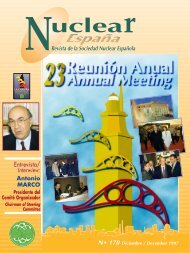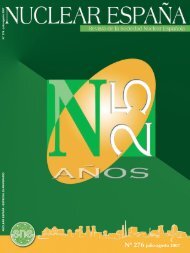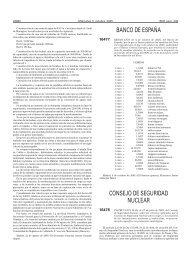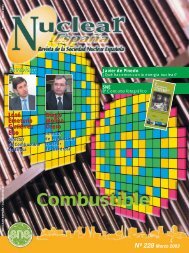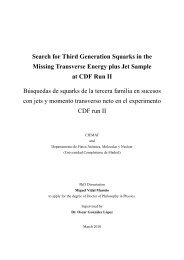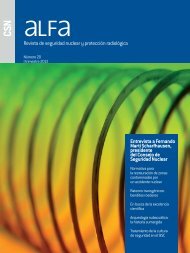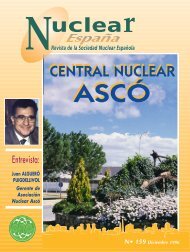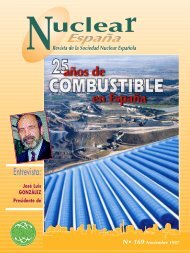EntrEntr evista/evista/ InterInter viewview
EntrEntr evista/evista/ InterInter viewview
EntrEntr evista/evista/ InterInter viewview
Create successful ePaper yourself
Turn your PDF publications into a flip-book with our unique Google optimized e-Paper software.
include the fact that, in 1999, gross electric energy<br />
production of the two units combined amounted to<br />
a maximum for one year, with a total of 15,645<br />
million kWh. In addition, Unit II obtained the<br />
maximum yearly production per unit, with a total of<br />
8,395 million kWh.<br />
Unit II continued operating in cycle XII, and it was<br />
disconnected on two occasions (April and June) due<br />
to reactor scrams that resulted in a total of 13.5<br />
hours off-line.<br />
At year’s end, both Units had been operating at<br />
60% power since 21:00 hours on December 31, as<br />
required by the Ministerial Order issued in<br />
preparation for the electric sector’s transition to the<br />
year 2000. Once the transition had been made<br />
without any incident occurring, power-up began at<br />
03:00 hours on January 1 and the plant reached<br />
100% power at 09:30 hours on the same day.<br />
The Almaraz and Trillo power plants are currently<br />
in the process of reorganizing under a single General<br />
Management, and technical and administrative<br />
supports have been grouped together for the purpose<br />
of leveraging the capabilities required for safe,<br />
reliable operation of the Units.<br />
By Unit, the most significant activities during the<br />
year were as follows:<br />
UNIT I<br />
The most significant activities undertaken were<br />
the thirteenth refueling outage and another outage of<br />
this Unit for replacing a bearing in one of the reactor<br />
cooling pumps.<br />
Gross electric energy production during the year<br />
was 7,250 million kWh., with a unit capability factor<br />
of 85.71% and a time availability factor of 86.91%.<br />
Accumulated production at source is 115,667<br />
million kWh.<br />
UNIT II<br />
As indicated above, this Unit continued to operate<br />
in its twelfth operating cycle and thus had no<br />
refueling outage. The only outages were two reactor<br />
scrams that are described in the section on incidents.<br />
Gross electric energy production during the year<br />
was 8,395 million kWh, with a unit capability factor<br />
of 98.13% and a time availability factor of 99.85%.<br />
Accumulated production at source is 112,223<br />
million kWh.<br />
THIRTEENTH REFUELING UNIT I<br />
This refueling outage began on schedule at 00:00<br />
hours on May 29, when the alternator was<br />
disconnected from the grid. The most significant<br />
activities included the following:<br />
• Measurement of the control rod drop time.<br />
• During primary circuit cooling, abnormally high<br />
radiation values, as compared to those obtained in<br />
the previous refueling, were detected at Plant points<br />
in contact with this circuit and associated systems,<br />
resulting from failure of a secondary reactor neutron<br />
source that contributed to propagation of isotopes<br />
Sb-124 and Sb-122 in RCS water. For this reason, a<br />
cooling pump was kept in service in the primary<br />
circuit, thus prolonging the filtering activities until<br />
activity levels in primary circuit water were lowered<br />
to EPRI-recommended values.<br />
• Activity levels at the operating elevation were<br />
similar to those obtained in the previous refueling,<br />
and they did not vary during the whole time the fuel<br />
and neutron sources were being unloaded. A visual<br />
inspection of nozzles and grids was performed in<br />
parallel with fuel assembly unloading, with<br />
satisfactory results.<br />
• The three steam generators were drained and<br />
fue que la Unidad I permaneció<br />
operando acoplada a la red desde el<br />
inicio del pasado ciclo (ciclo XIII,<br />
17 de diciembre de 1997), hasta el<br />
desacoplamiento para la decimotercera<br />
parada para recarga de combustible<br />
(29 mayo), lo que supuso<br />
un total de 528 días de acoplamiento<br />
ininterrumpido. Este hito supuso<br />
el récord mundial de operación a<br />
potencia entre las plantas de<br />
Westinghouse de tres lazos. La producción<br />
de energía eléctrica bruta<br />
generada en el ciclo fue de<br />
11.945.090 MWh, la más elevada<br />
en un ciclo en C.N. Almaraz.<br />
Entre los hitos alcanzados a lo largo<br />
del año, cabe destacar que en<br />
1999 se alcanzó la máxima producción<br />
de energía eléctrica bruta entre<br />
el conjunto de las dos unidades en<br />
un año, con un total de 15.645 millones<br />
de kWh. Asimismo, la<br />
Unidad II obtuvo la máxima producción<br />
anual por unidad, con un<br />
total de 8.395 millones de kWh.<br />
La Unidad II permaneció operando<br />
en el ciclo XII, desacoplándose<br />
en dos ocasiones (abril y junio), por<br />
paradas automáticas de reactor que<br />
supusieron un desacoplamiento total<br />
de la red en el año de 13,5 horas.<br />
Al finalizar el año, ambas<br />
Unidades se encontraban operando<br />
al 60% de potencia desde las 21 horas<br />
del 31 de diciembre, de acuerdo<br />
con lo requerido en la Orden<br />
Ministerial emitida para abordar el<br />
tránsito al año 2000 en el sector<br />
eléctrico. Pasado el citado tránsito<br />
sin producirse ninguna incidencia, a<br />
las 03.00 horas del día 1 de enero,<br />
se inició la subida de potencia, alcanzando<br />
el 100% a las 09.30 horas<br />
del mismo día.<br />
Las centrales de Almaraz y Trillo<br />
se encuentran en proceso de una<br />
nueva organización, bajo una<br />
Dirección General única, tras lo que<br />
se ha procedido a la agrupación de<br />
los apoyos técnicos y administrativos,<br />
basada en la potenciación de<br />
las capacidades para conseguir una<br />
explotación más segura y fiable de<br />
las Unidades.<br />
Por Unidad, las actividades más<br />
destacables, han sido las siguientes:<br />
UNIDAD I<br />
Las actividades más destacables<br />
llevadas a cabo fueron la parada para<br />
la decimotercera recarga de combustible,<br />
y otra parada de esta<br />
Unidad para la sustitución de un cojinete<br />
a una de las bombas de refrigeración<br />
del reactor.<br />
La producción de energía eléctrica<br />
bruta en el año fue de 7.250 millones<br />
de kWh., con un factor de<br />
disponibilidad del 85,71%, y un<br />
factor de operación del 86,91%. La<br />
producción acumulada al origen es<br />
de 115.667 millones de kWh.<br />
UNIDAD II<br />
Tal como se ha indicado, esta<br />
Unidad permaneció en su duodécimo<br />
ciclo de operación, por lo que<br />
no tuvo parada de recarga. Las únicas<br />
paradas fueron dos paradas automáticas<br />
de reactor que se describen<br />
en el apartado de incidencias.<br />
La producción de energía eléctrica<br />
bruta en el año fue de 8.395 millones<br />
de kWh, con un factor de disponibilidad<br />
del 98,13%, y un factor<br />
de operación del 99,85%. La producción<br />
acumulada al origen es de<br />
112.223 millones de kWh.<br />
A b r i l 2 0 0 0<br />
R e v i s t a S N E





